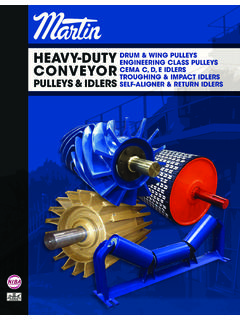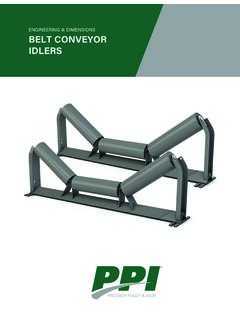Transcription of BELT SPECIFICATION BROCHURE - Conveyor Belting
1 belt SPECIFICATION . BROCHURE . For technical assistance please contact our Technical Advisor on: 028 9335 2844 or 30 CHURCH ROAD, BALLYNURE, CO ANTRIM, BT39 9UF. Tel: 028 9335 2844 Fax: 028 9334 2382. Introduction Sythentic fibre materials are increasingly superseding both the natural and semi-synthetic raw materials also in technical applications. TECNIFLEX rubber Conveyor belt with fully synthetic inserts based on polyester/ polyamide follows this trend. Only first class fabric is used for production. This Conveyor belt has the following important features: Highly resistant to dynamic stress Extremely puncture proof Capable of troughing up to 36 degree Low strain Non rotting TECNIFLEX rubber Conveyor belts with EP inserts stand their daily tests under the tough conditions in the steel industry, in metallurgy, coal mining, in the chemical and potash industries and in lime and rock working fields, above all in the continuous handling of bulk goods.
2 In connection with one or two puncture protective inserts (breakers) giving the belt a high weft strength, these heavy-duty Conveyor belts can be extremely loaded under maximum stress. Conveyor belt Designs Corresponding to our production programme, the following belt types, belt widths and cover panel thickness have proven themselves in the field. Cover Panel Thickness Carcass Thickness belt Thickness belt Width Kg/m2. TS (mm) LS (mm) (mm) (mm). 3 8 EP 250/2. 5 3 EP 315/2. 5 3 9 3 5 3 EP 315/3. 6 2 3 11. 8 3 3 14. 3 5 EP 400/3. 6 2 8 3 3 5 EP 500/3 6 8 3 10 3 3 5 EP 500/4 6 2 8 2 10 3 47A MOOR ROAD, COALISLAND, CO. TYRONE,BT71 4QB TEL +44 (0)28 8774 1418.
3 Cover Panel Thickness Carcass Thickness belt Thickness belt Width Kg/m2. TS (mm) LS (mm) (mm) (mm). 3 5 EP 630/4 6 2 8 3 19 10 3 3 5 14 EP 800/4 6 6 2 8 3 10 3 3 6 5 15 6 EP 800/5 6 2 6 14. 8 3 6 17. 10 3 6 19. 3 5 EP 1000/4 6 2 8 3 10 3 3 11. 5 13. EP 1000/5 6 2 8 3 21 10 3 3 5 EP 1200/6 6 2 19 8 3 10 3 25 3 5 EP 1250/4 6 2 8 3 10 3 5 8 6 2 8 16. EP 1600/5. 8 3 8 19. 10 3 8 21. 5 15 9 6 2 9 17. EP 2000/5. 8 3 24 9 20. 10 3 9 22. FOR TECHNICAL ASSISTANCE PLEASE CONTACT OUR TECHNICAL ADVISOR ON: +44 (0)28 8774 1418 OR Selection of Rubber Cover Panels The quality of Rubber cover panels is developed from natural rubber or blends of natural and synthetic rubber for most varied applications.
4 Cover Tensile Strength Elongation at Failure Abrasion Remarks Quality Min N/mm2 Min % Max mm3. For Conveyor belts up to type EP 1000/4. Z 15 350 250 under low stress in temperature climates. For Conveyor belts from type EP500/3. Y 20 400 150 under high stress in temperature climates. For Conveyor belts from type EP 500/3. X 25 450 120 under high stress in arid, humid and alternate climates. For Conveyor belts from EP 500/3 under W 18 400 90 very high stress (abrasion). Best abrasion quality. WS 15 400 60. For oil resistant applications. G 15 400 150. For flame resistant applications. SD 20 400 150. For cold resistant applications R 17 450 100 up to-60oC.
5 For heat resistant applications T 10 300 180 110 130oC. For heat resistant applications TW 10 200 200 150 170oC. For heat resistant applications TH 10 200 200 180 200oC. For heat resistant applications THS 10 200 200 200 220oC. Rupture Strength Of major importance to the service life of a Conveyor belt is the interaction and interconnection between the individual fabric inserts and rubber cover panels. Modern impregnating and rubberising process in production for a uniform belt structure. The following minimum rupture strengths are guaranteed: - Between cover panels and carcasses N/mm - Between the individual fabric inserts of the carcass 5 N/mm Rupture Strength Rubber Conveyor belts with EP inserts have a strain of to 2%.
6 Special processes in fabric production and fur- ther processing guarantee strain figures lying below of the specified rupture force of 10%. The added use of breaker inserts does not change the strain behaviour. 47A MOOR ROAD, COALISLAND, CO. TYRONE,BT71 4QB TEL +44 (0)28 8774 1418. Application TECNIFLEX Conveyor belts with EP inserts and breaker inserts are especially applicable to conveyors of production handling facilities and belt installations up to axle base of 1,500m. belt Speeds The following belt speeds are permissible: - Equipment with carrying roller stations 6m/sec - Equipment with cable-braced garland stations and stations with single cushioning - Equipment with solely cable-braced garland stations 10m/sec Minimum Drum Diameter To reach an optimum life of the Conveyor belt and the joint, we recommend that the following minimum drum diameters be kept: Minimum drum diameter for EP Conveyor belt (mm).
7 Utilisation of the permissible belt tension belt 60%.. 100%.. 30%.. 60%.. Under 30%.. Type Return Return Driving Return Snub Driving Snub Driving Snub Drum Drum Drum Drum Drum Drum Drum Drum Drum 250/2 200 160 125 160 125 100 125 100 80. 315/2 200 160 125 160 125 100 125 100 80. 315/3 315 250 200 250 200 160 200 160 125. 400/3 315 250 200 250 200 160 200 160 125. 500/3 315 250 200 250 200 160 200 160 125. 500/4 400 315 250 315 250 200 250 200 160. 630/3 400 315 250 315 250 200 250 200 160. 630/4 500 400 315 400 315 250 315 250 200. 800/4 630 500 400 500 400 315 400 315 250. 1000/3 500 400 315 400 315 250 315 250 250. 1000/4 630 500 400 500 400 315 400 315 315.
8 1250/3 630 500 400 500 400 315 400 315 315. 1250/4 800 630 500 630 500 400 500 400 315. 1600/4 800 630 500 630 500 400 500 400 315. 2000/4 1000 800 630 800 630 500 630 500 400. 2500/4 1252 1000 800 1000 800 630 800 630 500. 3150/5 1400 1250 1000 1250 1000 800 1000 800 630. FOR TECHNICAL ASSISTANCE PLEASE CONTACT OUR TECHNICAL ADVISOR ON: +44 (0)28 8774 1418 OR Formulas Max Product Weight on belt belt Length belt Speed in Feet per Minute at any one Time When pulleys are approximately When load is known per square the same size foot: L=(D+d)/2 x +2C. P + G1 x C (in feet) x W (in feet). When one pulley is much larger S = D X RPM X 2618 X When Load is known by lbs.
9 Per than other(atleast 3 times hour: larger). P= G2 / (S X 60(minutes)) x C. L+(D+d)/2 x +2C +((Dd). (feet). 2)/4C. Horsepower to Drive Effective Tension Tight Side Tension a Conveyor belt (pull need to move belt and load (total tension to move belt and For level conveyors: horizontally) load horizontally). Load E = F x (P+M) E2= E + E1. HP= (F x S x (P+M))/33,000. Effective Tension Tight Side Tension For inclined conveyors: HP= ((PxB) + (P+M) x F x (determines working strength of belt (addition tension required to S)/33,000 to handle job on per inch width basis). prevent slippage on pulley drive). T= E2 / W. Key Symbols G1 Load per sq. Or cu. Ft. (lbs.) W belt Width B Sine of angle of include HP Horse Power (inches).
10 C Centre to centre distance (inches) K Drive factor G2 Load per hour (lbs.). (see table 2 below). HP Horse Power D Diameter drive pulley (inches) L belt length K Drive factor (see table 2 below). (inches) d Diameter tail pulley (inches) M belt L belt length (inches). weight (overall length not c2c). M belt weight (overall length not c2c). E Effective tension (lbs.) P Product weight (lbs.). P Product weight (lbs.). E1 Slack side tension (lbs.) RPM Revolutions per RPM Revolutions per minute minute S Speed feet per minute E2 Tight side tension (lbs.) S Speed feet per minute T Operating tension PIW (lbs.). F Coefficient of friction (see table 1 below) T. W belt Width (inches).








